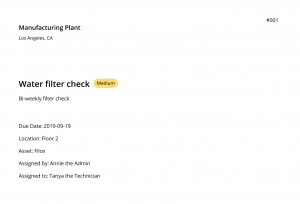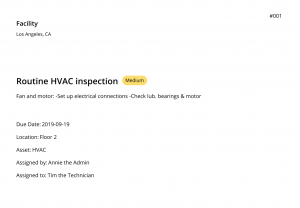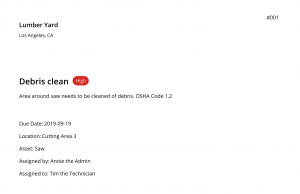Work Order Template
What is a Work Order Template?
Answered September 19 2019
A wide variety of businesses and organizations rely on work orders to get things done. Work orders help supervisors manage the incoming requests with outgoing activity. Work order records and work order reports can also provide analytic data to make big-picture business decisions down the road.
What is a Work Order?
A work order is a paper or electronic document that outlines a service request or maintenance activity that must be performed. Using a work order template saves time and helps to ensure that information collected is consistent and complete.
The Purpose of a Work Order
Work orders exist to outline the maintenance need, provide instructions, estimate costs, and schedule resources.
How to Format a Work Order
Work orders should be formatted in an easy-to-use manner and contain all the critical information needed to complete the task. The name and contact information of the person making the work order request is usually at the top with the details of the work order following. Be sure to leave room for details and instructions including time parameters and deadlines. An accounting of labor and materials required as well as a spot to record actual usage and hours will follow. Correct formatting is crucial to cost tracking and overall work order processes.
Three Ways to Create Work Orders
Work orders are typically created manually in a spreadsheet document, using a work order generator, or automatically within a computerized maintenance management system (CMMS) solution. Let’s take a look at each of these tools.
Using a Spreadsheet
Spreadsheet-based work orders are fast, customizable, and inexpensive. They can be the best solution for smaller or start-up companies.
Work Order Generator
Many companies offer a free work order generator online. These generators prompt the user with a list of questions, making it easy to create a complete document quickly.
CMMS Work Order
Organizations that rely on a CMMS to manage and track their assets can automatically generate work orders. These may be based on a particular preventive maintenance schedule, asset condition, or sensor trigger.
Six Important Fields to Include in a Work Order Template
Most work orders contain common elements. Here are the six most important:
1. Description of Task or Need
Work orders should detail the task or need. The more information provided in this field, the better. It’s important to anticipate the data other users of the work order will need.
2. Name of Requester
Both the name and contact information of the requesting person or individual should be clearly specified. It’s important to be able to contact the requester with additional questions or to communicate problems with completing the task.
3. Estimated Completion Date
The expected completion date helps both the requester and the technician understand time limitations and expectations.
4. Name of Person or Team Responsible for Completing Task
It’s important to have one person accountable for completing the actual service request. Questions about problems, timing or resources can be directed to that individual throughout the process.
5. Location of Activities
The larger the complex or facility, the more important it is to specify the exact location of the service request. This may include building number, room number, or even the location of a particular component of an asset.
6. Prerequisites to Completion
This may include items such as parts, tools, testing equipment, and skill level of technicians.
Three Common Work Order Templates
Preventive Maintenance Work Order Template

Inspection Work Order Template

Safety Work Order Template

Work Order Template Generator and Downloadable PDF
If you’re ready to get started, check out this work order template generator. Simply fill in all the fields with your company’s specific information and download a free PDF that’s ready to use.
Conclusion
Work orders are critical to staying organized when it comes to managing maintenance or service requests. Regardless of what industry you work in, when a customer request comes in, you want to respond quickly and effectively. Work order templates help you gather and organize all the important information to do just that.
Want to keep reading?
How to Write a Work Order Letter
What is the difference between a paper work order and a digital work order?
The Recommended Method of Documenting Preventive Maintenance
4,000+ COMPANIES RELY ON ASSET OPERATIONS MANAGEMENT
Leading the Way to a Better Future for Maintenance and Reliability
Your asset and equipment data doesn't belong in a silo. UpKeep makes it simple to see where everything stands, all in one place. That means less guesswork and more time to focus on what matters.


![[Review Badge] GetApp CMMS 2022 (Dark)](https://www.datocms-assets.com/38028/1673900459-get-app-logo-dark.png?auto=compress&fm=webp&w=347)
![[Review Badge] Gartner Peer Insights (Dark)](https://www.datocms-assets.com/38028/1673900494-gartner-logo-dark.png?auto=compress&fm=webp&w=336)
